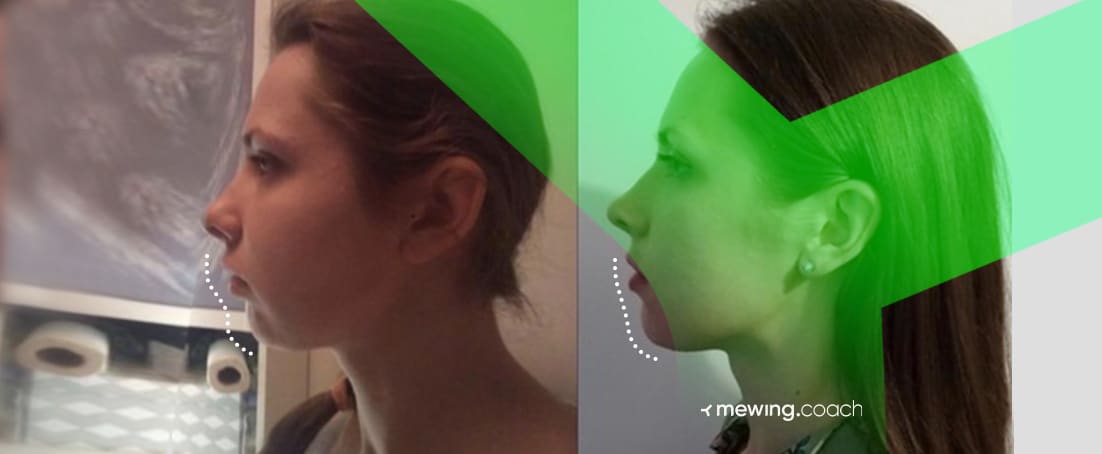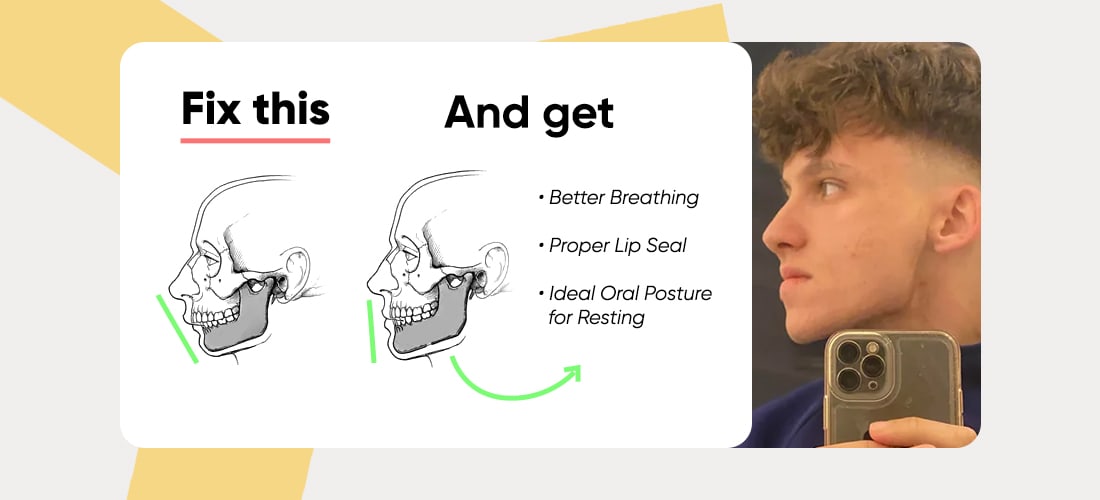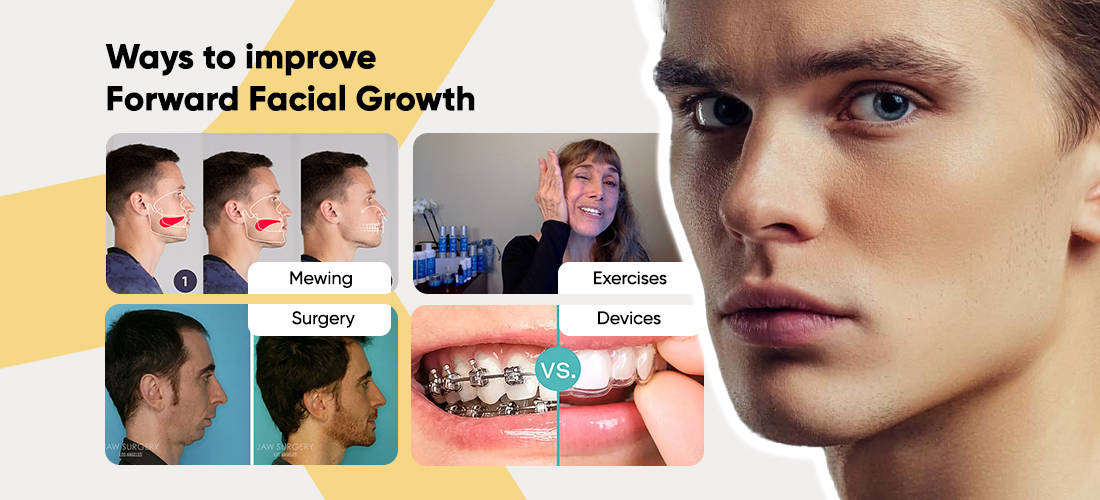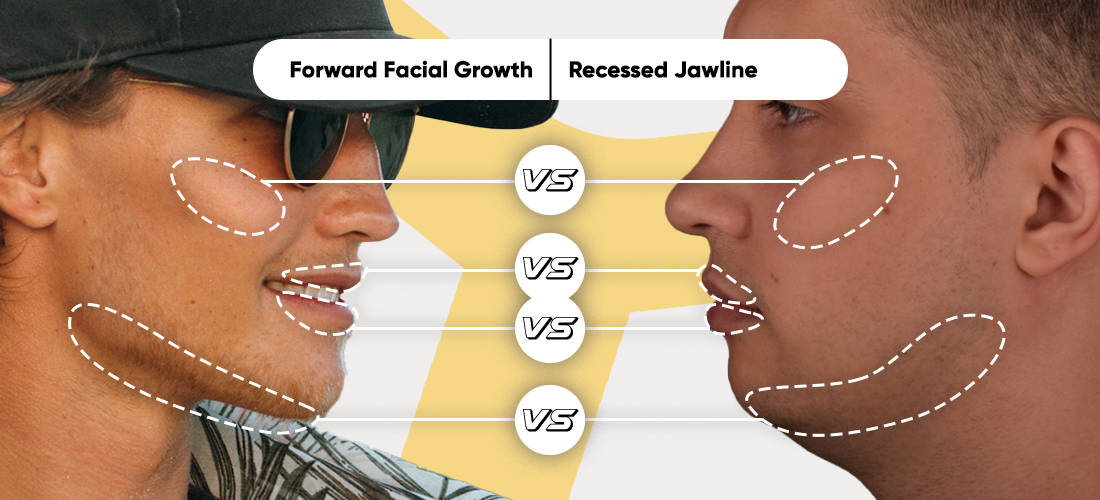
Your jaw size significantly influences your dental condition, appearance, and overall health. TMJ, sleep apnea, and an undesirable look owing to uneven or projecting teeth can result from an underdeveloped jaw.
Jaw surgery used to be the standard treatment for these cosmetic concerns. Even if surgical correction of an underdeveloped jaw is successful, it comes at a price – prolonged recovery time and discomfort.
What if we told you that jaw surgery is not necessary and there are other alternatives despite the chin types? Take a quick quiz below and find out!
In this article, we’ll elaborate on:
- 📖 Forward facial growth: Definition.
- 🤔 Benefits of forward facial growth
- 💡 How to get forward facial growth
What is Forward Facial Growth?
Your face is composed of 22 bones in total, separated into two zones. The face is formed in one area, while the skull is protected in the other. The maxilla is a bone that creates the face’s bone structure. It basically is the bone that forms the upper jaw, cheeks, and lower eye sockets.
Because of genetics or perhaps even face trauma, the maxilla may not ever grow properly in certain people and will always be recessed. This indicates that your upper jaw line is sunken, which can lead to a misaligned bite, recessed cheeks, as well as the appearance of your lower jaw being overly apparent in comparison.
Luckily, it is treatable, and this procedure is known as forward facial growth. There are various natural ways to practice forward facial growth, like mewing.
Benefits of Forward Facial Growth
There are plenty of benefits of forward facial growth. Here are some of them:

Better Breathing
Mouth breathing can threaten your health, resulting in low blood oxygenation, affecting the whole body. Chronic mouth breathing also causes swallowing, drying out the mouth, and improper jaw and palate growth.
The nasal passageways are intended to cleanse and warm up the air as you inhale; therefore, nasal breathing is recommended.
Proper Lip Seal
This refers to how your mouth looks when it is not actively engaged in eating or talking. Correct lip seal may be challenging, if not unachievable, in situations of an undeveloped jaw. Facial growth guidance assists in the training of the lips to stay sealed when resting.
Ideal Oral Posture for Resting
Proper breathing and overall health and wellness depend on the tongue’s position when at rest. The roof of the mouth should be where the tongue rests. Mouth breathing and a small upper palate are the effects of a low-lying tongue that lies at the bottom of the mouth.
How to Get Forward Facial Growth

If you want to get prominent jaw growth, there are several methods that can help. Proper tongue posture or open mouth posture are some of the options that can also be used as ways to lose cheek fat.
There are also many forward facial growth exercises to make your jawline stronger and more aesthetically appealing. These jawline exercises are incredibly easy to practice and can be incorporated into your home workout routine. You could do them whenever, but ensure you include them in your daily exercise plan.
Mewing
Incorrect tongue position is a simple reason that can lead to various problems like permanent teeth TMJ pain. That is why it’s crucial to implement tongue positioning habits. This is where mewing helps!
Mewing helps improve the face features, so performing regular mewing will improve your jaw structure and face shape with time – just ensure you know how to do mewing correctly. Don’t worry; it is easy to achieve the correct tongue posture by mewing just following these steps:
- Put your lips together and lightly touch your teeth.
- Place your tongue on the mouth’s roof and gently massage it.
- Engage the third posterior of your tongue.
- Breathe from your nose and ensure that you are not obstructing the airway.
Once you’ve mastered this technique, you can see that mewing benefits you in many ways and is a good solution to how you can keep your form perfect at all times. Download our Mewing.Coach app where you can constantly keep track and successfully achieve forward facial growth.
Neck Curl Exercises
Consider this to be the neck equivalent of an abdominal curl. The tongue should be forced on the roof of the mouth while you are lying on your back. This will work the front neck muscles.
Raise two inches off the ground while bringing your chin to your chest. Keep your chin down, and don’t lift your stomach. First, begin with three sets of 10 and then increase the number of sets.
Chin-Ups
Sit up straight and shut your mouth. Move your lower jaw forward, lifting your lower lip, and hold for 10-15 seconds. You should perform 3 sets of the exercise, repeating the motions 15 times.
Collar Bone Back-Up Exercise
Pull your head back a few inches while maintaining it parallel with the ground to feel the muscles along either side of your throat contract and rest. Before holding the posture for over 30 seconds, begin with three sets of 10 repetitions.
Tongue Twisters
Tongue twisters are a group of words or expressions that are challenging to pronounce properly. Sometimes native speakers may find these humorous phrases hard because of the odd phrasing and combinations of words.
Speaking these difficult sentences aloud will help you to loosen your facial muscles. Begin by using some simpler tongue twisters. Next, try some medium-level tongue twisters. Lastly, move to some challenging ones.
Chin Tucking Exercise
The chin tucking exercise targets the muscles underneath the jaw and is straightforward to perform:
To begin, ensure you have a straight back and maintain a parallel line with the ground. Start by gently moving your neck backward and forward, allowing the muscles to stretch and contract. Return to your starting position.
While doing this exercise, it’s important to feel the muscle engagement. This exercise helps to strengthen and define the collarbone and neck area. You can gradually increase the intensity by aiming for 30 repetitions per day, starting with 10 sets initially. Remember to take a short break between each set.
The Jaw Bone Restorer
Sit comfortably or stand in and place your thumbs side by side under your chin. Your thumb should now be pressed onto your jaw and moved higher to your ears while you begin to press your chin down into your neck. The muscles in that area are toned, and the jawline is given a decent form as a result. We recommend repeating this set 10 times a day.
Sagging Chin Jawline Exercise
You could perform this movement from the comfort of your own house without any instruction. It’s as simple as sitting at a table and putting your hands under your chin. Your chin should be placed above your hands as you place your elbows on the table.
Attempt to open your mouth gently. As you simultaneously move your fists to your jaws, pressure is created. After a while of being in this position, relax. Begin with 10 sets daily; if you feel comfortable, increase that number to 30 the next day.
Forward Facial Growth Surgery
Individuals with inadequate bite or jaws placed in the wrong way can benefit from corrective jaw surgery. Jaw development happens gradually; in certain cases, the lower and upper jaws may not line up at the completion of the process.
The incongruent growth of the jaws may be brought on by injury to the jaw throughout growth. The outcome may lead to various issues that may impair speech, chewing ability, long-term dental health, and outward appearance.
A consultation appointment is necessary with x-rays and models before any treatment begins. Typically, your orthodontist will provide us with your pre-orthodontic models.
However, even if you undergo surgery, you should still perform jawline improvement exercises to keep the new look intact.
Orthodontic Devices
Repositioning individual teeth within the jaws and gums is necessary to correct malocclusion, and this procedure may only be completed in stages. Because of this, orthodontists employ tools to assist in applying the constant correcting forces required to move teeth within the jaw and gums.
When the arrangement is over, these devices can be taken out or stay in place to stop the initial issue from happening again. Orthodontists employ a variety of tools, including space maintainers, aligners, braces, and retainers.
You can also check the connection between mewing and various orthodontic devices to support your transformation.
Forward Facial Growth vs. Recessed Jawline
Although forward facial growth and recessed jawline may appear highly comparable, they are not the same. Forward facial growth is any method that raises the maxilla. Your face appears to be uplifted more as a result of the process.
On the other hand, a recessed jawline is retreating slopes back toward the neck rather than sticking out or lying flat. It occurs when the bottom jaw is not aligned with the upper jaw. Although it’s typically an aesthetic problem, it can also be connected to more serious medical problems. In fact, there are four key differences which are:

- Cheek Line Differences – Your cheek line slopes down with forward face growth, while it is flat with a recessed jawline.
- Upper Lip Differences – In contrast to a wide angle in a recessed jawline, forwarding facial growth is seen as having a narrow angle.
- Lower Lip Differences – Forward facial growth has a narrow-angle, and the recessed jawline has a wide angle.
- Jawline Differences – In forward-growing facial development, your jawline is formed and prominent. In a recessed jawline, the jawline may be short and hidden.
Forward Facial Growth and Abnormal Development of Airways
There is more to the maxilla than just the bone supporting our teeth. The entire middle of our face is made up of the maxilla. It establishes our airway space, cheekbones, and mandibular posture.
A recessed maxilla can lead to crooked teeth, an underbite or overbite, and flat cheekbones. Forward facial growth can help rectify these issues by providing more room for the teeth and tongue. Therefore, the maxilla’s healthy development is crucial for both beauty as well for developing normal airways.
Forward facial growth is required for breathing through the nose, as well as maintaining the correct oral rest posture. Inadequate development of the maxilla may prevent breathing by obstructing the nasal passageway.
You can learn more about the importance of the development of the face and why breathing through the nose is healthier than mouth breathing in our nose vs. mouth breathing post.
Final Words: Can Forward Facial Growth Really Help?
It is in our nature to wish to have more defined facial features, whether for aesthetic, psychological, or health reasons. The jawline is a key piece of the puzzle, and in many cultures, people value a structured, evenly-balanced jaw. However, as many of us lack this ideal face feature, strategies have been created to help us get it.
Luckily, forward face growth is possible without the need for painful or expensive surgery. Facial exercises can change the shape of your face and get you the desired look with just some time and effort.
One way to improve your jaw muscles is through mewing. You can grow your jaw muscles through mewing and get amazing results. It may take some time before you see some changes, but it doesn’t cost you a thing, and it doesn’t require much effort.
Blitz Answers
Factors contributing to forward facial growth vary between children and adults.
Factors like genetics, nutrition, hormonal balance, and the environment contribute to the growth of the face.
Identifying specific signs or indicators can signal a lack of forward facial growth.
Signs of insufficient forward facial growth may include a chin that is set back, an underdeveloped midface, and poor dental alignment.
Lifestyle changes or interventions may influence or enhance forward facial growth.
Lifestyle changes such as eating well, getting enough sleep, and orthodontic treatments can influence the progression of facial growth.
Untreated or impaired forward facial growth can lead to potential consequences.
If left untreated or hindered, insufficient forward facial growth can result in problems such as misalignment of teeth, sleep apnea, breathing issues, and concerns about appearance.
Parents should understand the importance of monitoring and supporting healthy forward facial growth in their children.
Parents should keep an eye on their children’s dental progress, promote good oral hygiene practices, offer a well-rounded diet with essential nutrients, and consider orthodontic assessment if worried about facial development.
Myths or misconceptions exist regarding forward facial growth, necessitating awareness of evidence-based strategies for promotion.
Some common misconceptions involve the idea that external factors like chewing gum or facial exercises can significantly alter facial growth. While genetics primarily determine facial development, lifestyle choices can have some impact.
Psychological and emotional effects of facial growth issues can impact individuals, requiring coping strategies for self-esteem and confidence.
Challenges with facial growth can affect self-confidence and self-esteem, particularly during teenage years. Counseling, support networks, and orthodontic care can assist individuals in managing emotional repercussions.
Early detection and intervention can prevent long-term complications associated with untreated forward facial growth issues.
Neglected issues with facial growth could lead to misaligned teeth, breathing challenges, speech impediments, and aesthetic worries. Early identification through routine dental check-ups enables timely intervention to reduce the likelihood of long-term complications.




